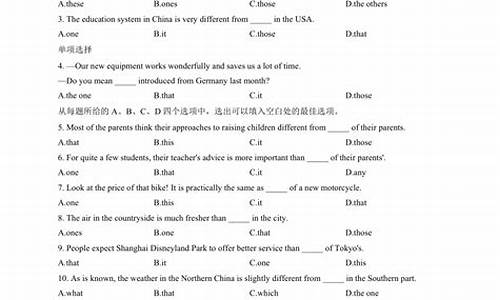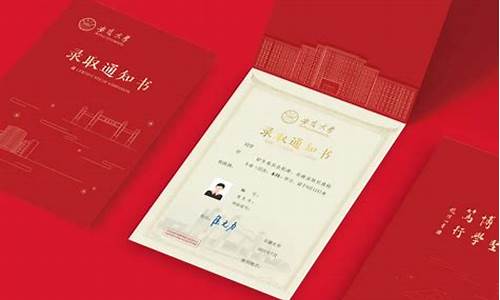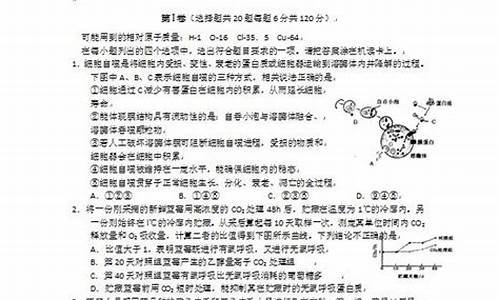您现在的位置是: 首页 > 教育改革 教育改革
高考英语语法题占多少,高考英语语法题
tamoadmin 2024-05-30 人已围观
简介1.几道高考英语语法题2.高中英语语法填空解题技巧是什么?3.高考英语语法题目类型和分布重点4.2017高考英语语法填空分类试题一.非谓语动词 一.不定式: 一)不定式的常考形式: 1) 一般形式:He decided to work harder in order to catch up with the others. 被动形式: He preferred to be assigned
1.几道高考英语语法题
2.高中英语语法填空解题技巧是什么?
3.高考英语语法题目类型和分布重点
4.2017高考英语语法填空分类试题

一.非谓语动词
一.不定式:
一)不定式的常考形式:
1) 一般形式:He decided to work harder in order to catch up with the others.
被动形式: He preferred to be assigned some heavier work to do.
语法功能: 表示与谓语动词同步发生
2) 完成形式:He pretended not to have seen me.
被动形式:The book is said to have been translated into many languages.
语法功能:表示发生在谓语动词之前
二)不定式常考的考点:
1)不定式做定语----将要发生
2)不定式做状语----目的
3)不定式充当名词功能---To see is to believe.
三)不定式的省略
1)感官动词 see, watch, observe, notice, look at, hear, listen to, smell, taste, feel
+ do 表示动作的完整性,真实性;
+ doing 表示动作的连续性,进行性
I saw him work in the garden yesterday.
昨天我看见他在花园里干活了。(强调"我看见了"这个事实)
I saw him working in the garden yesterday.
昨天我见他正在花园里干活。(强调"我见他正干活"这个动作)
" 感官动词后面接形容词而不是副词:The cake tastes good; It feels comfortable.
2) 使役动词 have bid make let 等词后不定式要省略但同1)一样被动以后要还原to
I 'd like to have John do it.
I have my package weighed.
Paul doesn't have to be made to learn.
3) help help sb do help sb to do help do help to do
四)有些动词后只跟不定式如:
want,wish,hope,manage,promise,refuse,pretend,plan, offer,decide,agree,expect allow sb to do, cause sb to do , permit sb to do, enable sb to do
force sb to do. be more likely to do love to do warn sb to do be able to do
be ambitious to do. begin to do . start to do
We agreed _______ here,but so far she hasn't turned up yet.(NMET
1995)
A.having met B.meeting C.to meet D.to have met (Key:C)
五) 有的时候to后面要接-ing形式
accustom (oneself) to; be accustomed to; face up to; in addition to; look forward to; object to; be reduced to; resign oneself to; be resigned to; resort to; sink to; be used to; be alternative to; be close/closeness to; be dedication/dedicated to; be opposition/opposed to; be similarity/similar to.
三、need/want 后的-ing形式具有被动的意思。其中,want不太常用。
He needs (a lot of) encouraging.
二. 动名词: 具有动作性特征的名词
1)是名词 seeing is believing
2)具有动词性特征可以带宾语 starving troops is necessary.
一)动名词的形式:
一般形式:I don't like you smoking.
完成形式:I regret not having taken your advice.
被动形式:This question is far from being settled.
二) 动名词常考的点
1)动名词做主语谓语动词为单数
2)在动名词和不定式中,做为介词的宾语是动名词
3)动名词的否定直接在其前加否定词,通过代词的宾格或所有格形式给出逻辑主语.
I would appreciate_______ back this afternoon.(MET 1992)
A.you to call B.you call C.you calling D.you're calling(Key:C your calling 也对)
I regret not having taken your advice.
4)有些词后只能接动名词
admit; appreciate; avoid; celebrate; consider; contemplate; defer; delay; deny; detest; discontinue; dislike; dispute; enjoy; it entails; escape; excuse; explain; fancy; feel like; finish; forgive; can't help; hinder; imagine; it involves; keep; it means; mention; mind; miss; it necessitates; pardon; postpone; practice; prevent; recall; report; resent; resist; risk; suggest; understand...
另外还有一些接-ing形式的常用说法:
it's no good; it's no/little/hardly any/ use; it's not/hardly/scarcely use; it's worthwhile; spend money/time; there's no; there's no point in; there's nothing worse than; what's the use/point...
5有些词后加不定式和动名词均可
remember, forget, try, stop, go on, cease, mean后面用不定式和-ing形式,意义截然不容。
I remembered to post the letters. (指未来/过去未来的动作)
I remembered posting/having posting the letters (我记得这个动作)
forgot remember的用法类似。
I regret to inform you that… 我很遗憾地通知你…
I regretted having left the firm after twenty years. 为了"二十年前的离开"而遗憾。
try to 努力 You really must try to overcome your shyness.
try -ing 试验 Try practicing five hours a day.
I mean to go, but my father would not allow me to. [打算、想]我想去,但我父亲不让我去。
To raise wage means increasing purchasing power. [意味着]赠加工资意味着增加购买力。
prefer的用法:
我宁愿在这里等。
3 分词:
现在分词主动进行,过去分词被动状态
现在分词的形式:
1)一般式: Do you see the man talking to the dean(主任)? (与谓语动词同步发生)
2)完成形式:Not having made adequate preparations, they failed. (发生谓语动词之前)
3)完成被动形式:Having been adapted, the script seems perfect.( 发生谓语动词之前且表示被动)
过去分词
1) 过去分词表示被动:Fight no battle unprepared.
2)过去分词的进行形式:You'll find the topic being discussed everywhere. (强调正在被做)
这三种非谓语动词,都可以构成复合结构,非谓语动词所修饰的成分是这些非谓语动词的逻辑主语。他们之间的一致关系--主动还是被动,往往就是考点。独立主格结构中,要注意的是分词与他前面的逻辑主语之间的主动被动的关系。
二:虚拟语气和情态动词
情态动词的基本用法及其区别
最近几年高考试题中常常借助语境来考查情态动词的基本用法及其区别,因此在平时学习时准确理解和掌握情态动词的基本用法十分重要。情态动词的用法复杂多变,在高考试题中,命题者常常利用语境和句子之间意义上的细微差别来考查学生对情态动词的理解和掌握。对于情态动词,除了要求考生能够准确掌握它们的基本用法外,还要充分利用高考试题所设置的语境来分析句子之间所体现的特殊关系。下面就近几年来高考试题中出现的情态动词的考点进行归纳分析,以便同学们复习掌握。
一、用"情态动词+have +done"结构表示对过去动作的推测,高考试题中常用过去时态或过去的时间状语给以暗示。情态动词的这一用法可以用 "对立统一"来概括。
1.当试题的前句和后句在动作和意义上相互补充说明,且整个句意在动作和时间上是一个整体时,我们可用"统一"关系来解决这样的试题。常见的结构有:
must have done:
表示对过去动作的肯定推测,常译作"一定做了……",只能用于肯定句中。其否定形式为can't/couldn't have done?
疑问式为Can/Could...have done?。
could /might have done:表示对过去发生的动作的可能性推测,常译作"可能做了……"。如:
1) My sister met him at the Grand Theater yesterday afternoon, so he
_____ your lecture. ?(上海 2000)
A. couldn't have attended
B. needn't have attended
C. mustn't have attended
D. shouldn't have attended
本题选A。
2) Jack ____ yet, otherwise he would have telephoned me. (上海'97
A. mustn't have arrived
B. shouldn't have arrived
C. can't have arrived
D. need not have arrived (C)
2.当试题的前后句在动作和意义上构成转折关系时,常借助"but, however, instead"等词来表示过去的动作与客观事实不符,这时我们就可以用"对立"关系来解决这样的试题。这种结构常见的有:
should have done / ought to have done:表示过去本应该做某事而实际上没有做。
should not have done / ought not to have done:表示过去本不应该做某事但事实上却做了。
由句中的连词but可知前后句之间是对立关系,分析题意可知本题应选C。
二、考查情态动词基本用法之间的比较和辨析。最近几年高考试题中常借助具体的语境来考查考生对那些最常见的情态动词的基本用法的理解和掌握,因此在做这样的试题时应认真分析语境中所含的实际意义,并结合情态动词的基本含义和用法做出正确的选择。
虚拟语气
" 最自然的虚拟状态:由should/would+原型时态(不含时间只含状态)
本质上是过去将来时:即,时间固定在过去将来,状态不同:一般、进行、完成、完成进行。
这时"虚拟语气"的产生往往是因为我们要表达"本来应该……"(而现在却还没有……)
(本来可以……,本来能……)
一些常见的句型中,就会出现这种虚拟语气,而处于从句之中,should 常常被省略掉
o suggest, advise, propose, recommend, plan;
o demand, order, direct, arrange, command, decide;
o require, request;
o think, expect, believe, insist, suspect.
由于他们的含义中包含"建议,假设,应该"这类的含义,所以,由他们引起的从句中,就会包含有should+原型时态构成的虚拟语气。
这些动词(以及他们的名次形式,分词形式)引起的从句还有其他的变形
主语从句,表语从句,同位语从句
It's suggested that…
My suggestion is that…
The only suggestion that...
The only suggestion I can give you now is that…
一些形容词引起的表语从句中,也会有同样的情况
important; necessary; essential
It's natural ; strange; incredible that
a pity; a shame; no wonder
? 由lest, for fear that, in case 引起的从句中多使用should
" 表达与事实相反
1. 与现在相反:使用[过去时]:
I wish I were not here! (一般现在'一般过去)
Suppose we were not here.
He loved me as if I were his own son. (一般现在'一般过去)
Hope I weren't always losing things! (现在进行'过去进行)
If only/If I hadn't been there! (现在完成'过去完成)
What if I hadn't been waiting right here! (现在完成进行'过去完成进行)
常考句型:It's (high) time (that)…; would rather (that)…
这两个从句,只能表达对现在的看法,所以,从句中只有一般过去时。
2. 与过去相反:过去完成时;
3. 与将来相反?将来的事情没有发生,所以只能推测且实现可能很小
I wish he could not smoke any more.
不过,由于可以用be to表示将来;所以,虚拟语气中经常出现were to;也是CET-4的常考语法点。
" 虚拟条件句
o if 部分,做一个与事实相反的假设(所以只有一般过去和过去完成)
o 主句部分,这是表示基于这个假设的推测,一般使用情态动词would,少数情况下使用could/might/should。
o 注意:两个部分之间,是有逻辑关系,而在两部分的谓语动词时态上,没有必然的联系。
" 注意,虚拟条件句中的if可以省略,造成were/had提前,产生倒装。
" 隐含的非真实条件 :由特殊的词给出条件: with, without, in , but for, otherwise, or
How could I be happy without you? In his shoes, I would kill myself.
But for the storm, we would have arrived.
三、一致关系
一)主谓一致
1. 主谓一致(与插入语无关)
1主谓的分隔原则:主谓之间可以用定语从句或者省略的定语从句分隔。
2定语从句中的主谓一致:
3随前一致:
n. + together with n2
as well as
including
along with
with / of
accompanied with / by
4就近原则:n1 or n2 +v(就近原则)
either n1 or n2
5可数n1 and 可数n2+v(pl)
不可数n1 and 不可数n2+v(pl)
例外:war and peace is… war and peace是一个整体
但是如果主语表示的是同一个概念,同一人,同一事的时候,谓语动词用单数,这种结构的特征是and连接的两个词只有一个冠词。
The iron and steel industry is very important to our country.
The head master and mathematical teacher is coming.
The head master and the mathematical teacher are coming.
类似的还有:law and order bread and
butter black and white
To love and to be loved is …
A lawyer and a teacher are…
A lawyer and teacher is …
6随后原则:not A but B / not only A but also B+v.(与B一致)
7百分比结构:most , half , rest , some , majority , one+persent
of+n1+v.(由n1决定
8倒装结构的主谓一致:
a)There be +n 由名词决定动词
b)Among , between等介词位于句首引起倒装结构:
Among / Between …+系动词+n. (由名词决定动词)
9The+adj的主谓一致:
a)当表示"一类人",
b)当表示某一抽象概念时
The good is always attractive.
10 To do/doing/主从+vs
*More than one+n
many a +n.
a day or two
二)、倒装
1 全部倒装
是只将句子中的谓语动词全部置于主语之前。此结构通常只用与一般现在时和一般过去时。常见的结构有:Up went the plane = the plane went up.
1) here, there, now, then, thus等副词置于句首, 谓语动词常用be, come, go, lie, run。
2) 表示运动方向的副词(back, down, off, up)或地点状语置于句首,谓语表示运动的动词。
注意:1) 上述全部倒装的句型结构的主语必须是名词,如果主语是人称代词则不能倒装。Here he comes. Away they went. 2) 谓语动词是be的时候,不能倒装。 Here it is. Here you are.
3) 形容词短语/分词短语位于句首,引起倒装
*typical of characteristic of
*coinciding with + n
4) 表示地点范围的介词短语位于句首,谓语动词为系动词,一定引起倒装
In…(表语)+系动词+主,主同。
*在倒装句型答案中不能出现there
*常考介词要倒装:among between in at beneath
常考的系动词:be lie exist remain rest
部分倒装
1. 否定 adv 位于句首,引起倒装:not only, not until, hardly, scarcely,
seldom, rarely, no sooner…than
1) not until + 时间 + 主谓倒装,not until + 句子+主谓倒装
2) only+状语位于句首
only +ad. eg: recently
prep.短短语 eg: in recently years
从句 eg: when clause
only一个词本身不倒装
3) 在比较级结构中,than后面可以倒装,也可以不倒装。
部分倒装是指将谓语的一部分如助动词或情态倒装至主语之前。如果句中的谓语没有助动词或情态动词,则需添加助动词do, does或did,并将其置于主语之前。
? 1) Neither, nor, so 表示前面句子的共同否定或者肯定,产生倒装,一般主动词提前,谓语动词的其他部分就
4) as / though引导的让步从句必须将表语或状语提前 (形容词, 副词, 分词, 实义动词提前)。
as〔让步〕虽然,尽管〔词序倒装。语气比 though 强〕。
Successful as he is, he is not proud. 他虽成功,却不骄傲。
Women as she is, she's every brave.
Try hard as he will, he never seems able to do the work satisfactorily.
注意:A) 句首名词不能带任何冠词。B) 句首是实义动词, 其他助动词放在主语后。如果实义动词有宾语和状语, 随实义动词一起放在主语之前。
5) 其他部分倒装
a) so… that 句型中的so; such… that句型中的such位于句首时,需倒装。
So frightened was he that he did not dare to move an inch.
b) 在某些表示祝愿的句型中:May you all be happy.
c) 在虚拟语气条件句中从句谓语动词有were, had, should等词,可将if 省略,把 were, had, should 移到主语之前,采取部分倒装。Were I you, I would try it again.
四、复合句
从句可分为:
? 名词性从句' 主语从句、宾语从句、表语从句、同位语从句
? 形容词性从句'定语从句
? 副词性从句'状语从句
" 常考的关系代词:that; which; who/whom/whose; where; when; what; as。
" 常见的同位语从句现行词(that之前的抽象名词):fact, idea, news, hope, conclusion, evidence, opinion, problem, thought, understanding…
" 常用的引导词
o 时间状语从句:while; when; before; whenever; as; after; till; until; since; once; ever since; as/so long as; as soon as; no sooner… than; hardly… when; scarcely/barely… when; the moment/minute/instant; on (the point of) doing…
o 地点状语从句:where; wherever
o 原因状语从句:because; since; as; seeing that; considering that; now that; in that; for fear that; lest; owing to the fact that; because of the fact that; due to the fact that…
o 方式状语从句:as; as if; as though; how; save that…
o 比较状语从句:as; than; as… as; not so… as; hardly… than;
o 结果状语从句:so that; so… that; such… that; so as to…
o 条件状语从句:if; unless; in case; so long as; so far as; provided/providing/that; supposing; granted/granting that…; giving that…
o 让步状语从句:though; although; even if; even though; whether; as; however; no matter (what, how, when); for all that; in spite of the fact that; granted that; regardless of the fact that…
o 目的状语从句:that; so that; in order that; lest; for the fear that; in case…
定语从句:
which 引导的定语从句结构
1)which是关系代词,which后面应该加缺主语或者宾语的句子,
在这个句子中,which要作成分,作主语或者宾语
2)in which+完整的句子
which在定语从句中作in的宾语,所以不能作后面句子的主语
3)名词+of which+谓语动词
of which来修饰名词,名词在定语从句中作主语,所以后面直接跟谓语动词
I have five books three of which are borrowed from Mary.
4)介词+ which +to do 其功能相当于定语从句。
The key with which to open the door is lost.
5)定语从句的省略结构:
1. 如果that / which在定从中作 宾语,可以省略.
sub+vt+n+(which / that)+sub+vt
→s+vt+n+s+v
s+vt+n1+n2+vt
*当做题时,若发现两个名词在一起,但是似乎连不上,则一定省略that /
which,则动词为vt,做谓语。
6)定从的特殊省略
the way (in which) + 句子
the reason (why that)+句子 均为完整句
the time (that / when)+句子
I do remember the first time (that省) I ever heard the sweetest voice in the world.
By the time省that+句子,句子。
7)定从的主系省略(主+系可同时省)
即:which be , who be , that be可同时省
状语从句省略结构
这种省略从句主语的方式理论上需要满足以下两个条件:
第一、特定的状语从句引导词:although though even though when while if as
第二、从句主语和主句主语必须保持一致;
第三、从句的谓语必须是be动词,主语和be动词同进同出,比如上面的they和are要么同时省略,要么同时保留。
高考英语插入语及插入句的用法
在NMET中,插入语屡见不鲜,由于插入语通常与句中其它成分没有语法上的关系,因此给考生的理解带来一定困难。插入语多半用逗号与句子隔开,用来表示说话者对句子所表达的意思的态度。插入语可能是一个词、一个短语或一个句子。
一、常用做插入语的副词
indeed的确, surely无疑, however然而, obviously显然, frankly坦率地说, naturally自然, luckily (或happily) for sb.算某人幸运, fortunately幸好, strangely奇怪, hone stly真的, briefly简单地说等。
1. Surely, she won?t go to China Telecom with you.
当然她不会和你一起去中国电信。
2. Strangely, he has not been to China Unicom. Still more strangely, he has not called me.
奇怪,他未来过中国联通。更奇怪,他没给我打电话。
3. Fortunately, I found the book that I?d lost.
幸亏我找到了已丢失的那本书。
二、常见的作插入语的形容词或其短语
true真的, funny真可笑, strange to say说也奇怪, needless to say不用说, most impor tant of all最为重要, worse still更糟糕的等。
1. Strange to say (或True), he should have done such a thing.
说也奇怪(或真的),他竟然做出这样的事。
2. Most important of all, you each over?fulfilled your own task.
更为重要的,你们各自超额完成了自己的任务。
三、常用作插入语的介词短语
in a few words(或in sum, in short)简而言之, in other words换句话说, in a sense在某种意义上, in general一般说来, in my view在我看来, in his opinion(judgment)按照他的意见(判断), in conclusion总之, in summary概括地说, in fact事实上, in the first place首先, in addition此外, of course当然, to our knowledge据我们所知, to my joy(delight, satisfaction)使我欣慰(高兴、满意)的, to their surprise(astonis hment, amazement)使他们惊奇的, to her regret (disappointment)使她遗憾(失望)的, for instance(或example)例如, as a matter of fact事实上等。
几道高考英语语法题
英语高考的时候,不管是单词、 短语 、句型还是语法,都会被考察到,所以考生们一定要全面复习好这些知识。下面是我整理分享的高考英语语法填空必背知识,欢迎阅读与借鉴,希望对你们有帮助!
高考英语语法填空必背知识
一、部分过去式和过去分词不规则变化的动词
1. broadcast (broadcast, broadcast) 广播
2. flee (fled, fled) 逃跑
3. forbid (forbade, forbidden) 禁止
4. forgive (forgave, forgiven) 原谅
5. freeze (froze, frozen) 结冰
6. hang (作“绞死”讲,是规则的;作“悬挂”讲,其过去式过去分词都是hung)
7. lie (作“说谎”讲时,是规则的;作“位于”讲时,其过去式是lay,过去分词是lain)
8. seek (sought, sought) 寻求
9. shake (shook, shaken) 发抖
10. sing (sang, sung) 唱歌
11. sink (sank, sunk/sunken) 下沉
12. spread (spread, spread) 传播
13. swim (swam, swum) 游泳
14. tear (tore, torn) 撕碎
15. weave (wove, woven) 编织
二、以下动词加-ed或-ing要双写最后一个字母
双写规则口诀:重读闭音节有特点,词尾是两“辅”夹一“元”。
若把-ing,-er(-est),-ed添,辅音字母要双写全。
注:两“辅”夹一“元”:指单词最后三个字母是“辅音字母+元音字母+辅音字母”(最后一个字母如是w,x,y除外),其中元音字母所发的音是该单词的重音。即“以一个辅音字母结尾的重读闭音节词”。
1. admit (admitted, admitting) 承认
2. permit (permitted, permitting)允许
3. regret (regretted, regretting) 后悔
4. forget (forgotten, forgetting ) 忘记 unforgettable
5. control (controlled, controlling) 控制
6. occur (occurred, occurring) 出现
7. prefer (preferred, preferring) 宁愿
8. refer (referred, referring) 提到
9. equip (equipped, equipping) 装备
注意:quarrel, signal, travel中的l可双写(英国英语)也可不双写(美国英语) 另外注意:destroy (destroyed) employ (employed)
shyer; shyest
三、容易拼写错的数字
1. eighth第八 2. ninth第九 3. forty四十 4. twelfth第十二
5. twentieth第二十
四、注意形容词变名词时的拼写变化
1. long—length 长度— lengthen加长
2. wide—width 宽度—widen
3. high—height 高度—heighten
4. strong—strength力量 —strengthen
5.deep—depth—deepen
6. short—shortness—shorten
7.broad—broadness—broaden
8.large—largeness—enlarge
五、以-ic结尾的动词,应先把-ic变为-ick,再加ing或ed
1. picnic (picnicked, picnicking) 野餐
2.panic (panicked, panicked) a./ v.惊慌,恐慌,惶恐不安
六、个别名词的'复数拼写
1. German (Germans) 德国人
2. gulf (gulfs) 海湾
3. handkerchief (handkerchiefs) 手帕
4. hero (英雄),potato (土豆),tomato (西红柿) 等有生命的以-o结尾的名词变复数时要加-es。
5. roof (roofs) 房顶
6. stomach 胃 (其复数是stomachs而不是加es)
七、常用复数形式
1. headphones (耳机), trousers (裤子),sunglasses (太阳镜), scissors (剪刀), compasses (圆规)
2. noodles, vegetables, snacks小吃, 快餐,
3. make friends with 与...交朋友,in high/low spirits (情绪高涨/低落), have sports (进行体育活动)。
4. congratulations (祝贺)。
5. celebrations (庆祝),
八、注意动词变名词时的拼写变化
1. succeed—success成功
2. pronounce—pronunciation 发音
3. explain—explanation解释
4. decide—decision 决定
5. enter—entrance进入
6. permit—permission 允许
7. refuse—refusal 拒绝
8. consider—consideration 考虑
9. discover—discovery 发现
10. bury—burial 埋葬
11. conclude—conclusion 得出结论
12. arrive—arrival 到达
13. weigh—weight 重量
14.press--pressure压力
九、注意去不去e
possible—possibly 可能的 argue—argument judge—judgment
value—valuable courage—courageous
高考英语语法填空必背知识相关 文章 :
★ 高考英语语法填空进行时态知识点与必记的单词
★ 高考英语语法填空考点总结
★ 英语高考语法填空《英语语法手册》知识点
★ 高考英语语法填空一般时态知识点与训练题
★ 高考英语语法填空动词知识点与语法填空题与答案
★ 高考英语语法填空副词知识点与练习题
★ 高考英语语法填空解题策略
★ 英语高考语法填空规律总结与练习题
★ 高考英语语法填空技巧整理
★ 高考英语语法填空比较级知识点与强化训练题
高中英语语法填空解题技巧是什么?
1.选A.不定式表目的
2.选B。such as to固定搭配
3.选B.如果选A,主句的主语和从句的主语必须一致!但there be句型没有主语可以与exam的主语一致!
4.选C。there be句型和seems to do句型的混合
5.选C.对谓语动词seems反问,应用does,主语Fighting an artificial greenhouse effect应该用it指代,所以用doesn't it?
6.选B.After _____seemed an endless wait,在整个句中是充当时间状语的.而after后面应该接的是一个名词性从句.it不能用来引导名次性从句.所以只能用what。
高考英语语法题目类型和分布重点
技巧一:注意数词形式变化
英语中数词的形式变化主要包括基数词、序数词,以及个别后缀teen、ty的变化。偶尔还涉及到one/two的特殊变化形式 once/twice等。
做题时,要认真区分题目属于上述哪种类型的变化,切勿糊涂大意。
技巧二:熟记固定短语结构
在英语中有很多固定短语搭配,有些是习惯用法,没有规律可言,需要刻板记忆。比如:
The boys were playing in the garden,enjoying____,dirty but happy.
从句中的happy一词可以判断出男孩们的心情是开心的,因此可以用来搭配enjoy oneself短语,根据人称变化成代词复数形式,可知正确答案为themselves。
技巧三:判断从句引导词
从句考察是语法填空题里最常见的方向,用来检测学生对引导词的熟悉程度。比如:we did not done_____our fatherhad asked us to do.
通过观察,不难发现空白处为一个宾语从句的引导词,它在整句话中充当宾语形式,推断这个空白,应该填的是what。
引导词究竟该选择哪个,可以通过日常熟读文章培养语感熟记,也可以通过类型题死记硬背。
技巧四:注意短语动词结构
短语动词指的是以动词为中心的两个或多个词构成的短语,这一类短语通常是动词与副词或介词的联合使用。比如take care of、come from、look for、be made of等等。这一部分,需要通过不断加强记忆掌握。
技巧五:短语介词结构
短语介词就是由多个词组合在一起。表达介词作用的短语有except for、due to、instead of 等。通过举例不难发现,短语介词一般都有固定搭配,需要识记。
2017高考英语语法填空分类试题
虚拟语气
1.虚拟语气的标准句式
2.标准句式与综错句式
3.条件句的省略倒装
4.虚拟语气的含蓄条件句
介词with, without, under, in, but for 等表示含蓄条件;
连词but, or, or else等表示含蓄条件;
副词otherwise, unfortunately等表示转折假设:
5.省略主句的虚拟语气结构if only
6.用于宾语从句的虚拟语气
that宾语从句需用(should)十动词原形表示虚拟的动词:
advise, recommend, propose, suggest, insist, move, urge, command, direct, order, ask, demand, request, require, maintain, prefer, desire, vote that不可以省略;should可以省略:
以上动词的同词根名词在that同位语从句和表语从句的谓语需用(should)十动词原形
如:
insistence, preference, recommendation, suggestion, proposal, motion, desire, requirement, request, order, necessity
以上动词的同词根形容词及分词在that主语从句的谓语需用(should)十动词原形,如:
advisable, desirable, insistent, preferable, urgent; advised, arranged, commanded, demanded desired, ordered, proposed, recommended, requested, required, suggested; essential, important, natural, necessary, possible, proper, strange
7.用于目的状语从句的虚拟语气 in case; in fear that; lest
8.用于方式状语从句的虚拟语气
9.常用的虚拟语气句式
1) it is high time
2) would rather
3)情态动词完成式可以表示责备、推测语气;
倒 装
全部倒装与部分倒装:
1.否定词语置于句首
never, no, neither, hardly, scarcely, little, seldom, rarely, not until, nowhere, at no time, on no account, in no respects, in no sense, in no way, under no circumstances, by no means, no longer, no less, no more, no sooner, in vain
2. only十状语置于句首
only加副词:only then,only once
only加介词短语:only at that time,only in this way,only by doing
only加状语从句:only because, only when
3.not only……but also……置于句首
4.so……that……状语、表语置于句首
5.than引导的比较状语从句(可以)
6.表语+系动词+主语
7.存在句
8.as引导的方式状语从句(可以)
主谓一致
常出现在主谓部分倒装结构中;常出现在主语与谓语之间有定语从句或其他修饰结构的句子中;常出现关系代词作主语的定语从句中;
1.以-s结尾的名词的主谓一致
1学科名词2构词单复3专有名词
................................................
语法填空题作为一种新型题目,重点考察的是学生的词汇掌握能力、词语辨析、单句理解能力,这就对学生英语综合能力的应用提出了更高的要求。要下面是我为大家推荐的2017高考英语语法填空分类试题,仅供大家参考!
高考英语语法填空分类试题
一、考查词形转换
1. He must be (mental) disabled.
2. His teacher took a deep drink, smiled (warm), and thanked his student very much for the sweet water.
3. We drank together and talked (merry) till far into the night.
4. One Sunday morning in August I went to a local musical festival. I left it early because I had an appointment (late) that day.
5. This proverb is saying we have to let things go in their (nature) course.
6. But Jane knew from past experience that her (choose) of ties hardly ever pleased her father.
7. Mary felt (please), because there were many empty seats in the room.
8. ?That would be a very (reason) thing to do in a big city, but it could destroy a small village like ours,? Nick said.
9. ?But such a small thing couldn?t (possible) destroy a village.?
参考答案:1. mentally 2.warmly 3.merrily 4.later 5.natural
6.choice7. pleased 8.reasonable 9.possibly
二、考查非谓语动词
1. He spit it out, (say) it was awful.
2. I got on the bus and found a seat near the back, and then I noticed a man (sit) at the front.
3. He suddenly appeared in class one day, (wear) sun glasses.
4. ?In the beginning, there was only a very small amount of unfairness in the world, but everyone added a little, always (think) that it was only small and not very important, and look where we have ended up today.?
5. While she was getting me (settle) into a tiny but clean room, the head of the village was tying up his horse to my car to pull it to a small town some 20 kilometers away where there was a garage.
6. For example, the proverb, ?plucking up a crop (help) it grow?, is based on the following story.
7. She wished that he was as easy (please) as her mother, who was always delighted with perfume.
参考答案 1-7: saying sitting wearing thinking settled to help to please
三、考查谓语动词时态及语态
1. The sun was setting when my car (break) down near a remote and poor village.
2. Besides, shopping at this time of the year was not a pleasant experience: people stepped on your feet or (push) you with their elbows (肘部), hurrying ahead to get to a bargain.
3. He walked in as if he (buy) the school.
4. Her mother was excited. ?Your father has at last decided to stop smoking,? Jane____ (inform).
5. Suddenly, he (find) that he had run out of salt.
参考答案 1-5 :broken pushed had bought was informed found
四、考查形容词或副词的比较级
1. The teacher replied, ?You tasted the water. I tasted the gift. The water was simply the container for an act of kindness and love. Nothing could be (sweet).?
2. He was very tired after doing this for a whole day, but he felt very happy since the crop did ?grow? (high).
3. It might have made it a little (hard) for everybody because it meant they had to turn around, but that didn?t stop the kids in the class.
参考答案 1-3 :sweeter higher harder
高考英语语法填空答题技巧
一、已给单词提示题型的技巧
此类题可以考查学生对单词形式变化的掌握程度。单词形式变化主要有两种,一是词的形、数、式的变化,一是词的派生变化。在判断出词的变化之后还应该进一步审题,看是否需要使用复合的变化形式,这一点是很重要的。
技巧一:名词形式变化。
名词的形式变化主要有单数、复数、所有格的变化。
例:There are many students living at school,the(child) houses are all far from schoo1.
由students一词可以判断出横线处应填复数,且作为houses的定语,所以应用其所有格形式,故答案为child的复合变化形式? 复数的所有格children?s。
技巧二:动词形式变化。
动词的形式变化比较多,有谓语的变化(时态、语态、语气),有非谓语的变化(不定式、动名词、现在分词、过去分词)。
例:A talk(give) tomorrow is written by Professor Zhang.
句中的is written是整句的谓语,所以横线所在的动词应当用作非谓语。从tomorrow可以看出,报告是?将来?作的,故用不定式;且报告是give动作的承受者,故可以判断出横线所在处用give的不定式被动式?to be given。
技巧三:代词形式变化。
代词形式变化通常是与人称变化有关的三大类五小类,即人称代词(主格和宾格)、物主代词(形容词性和名词性)、反身代词。另外还有几个不定代词的形式变化,如no one/none、other/another等。
例:The king decided to see the painter by(he).
由介词by可以看出,横线处应填反身代词himself。
技巧四:形容词、副词比较级变化。
英语中大部分形容词和表方式的副词都有原级、比较级和最高级的变化。构成比较级和最高级的方式,或通过加后缀一er和.est,或在词前Imore/less和most/least,且形容词的最高级还要冠以the。
例:I am (tall)than Liu Wen.He is the tallest students in my class.
此题后句交代了LiuWen是班上最高的学生,那?我?肯定比他矮,所以不能用taller,只能用表示程度不如的?less tall?。
技巧五:数词形式变化。
数词的形式变化包括基数词、序数词,或加后缀一teen、ty的变化,甚至还有作分母用的序数词的单复数形式,以及one/two的特殊变化形式 once/twice
例:To my three sons I leave my seventeen horses.My eldest son shall take a half,my second son shall take a (three).
从上下文连续起来理解,这是一个分马的计划,大儿子分得a half,也就是?一半?或?二分之一?,那么二儿子应该得?三分之一?,所以要填入作分母的序数词?third?才能命中目标。
技巧六:词的派生。
词的派生现象在英语单词中是很常见的,派生现象主要发生在名词、动词、形容词、副词四种词中。这种题型还有可能检测学生对词根、前后缀、派生词的掌握。
例:Lious lost his wallet yesterday,SO he was very____(happiness).
在这道题中,学生很容易判断出该用形容词;钱包丢了,人应该是不开心的,所以要再加个前缀un,就成了unhappy。









